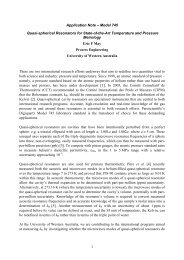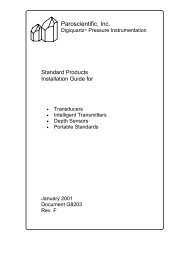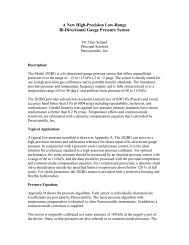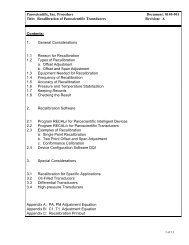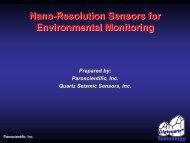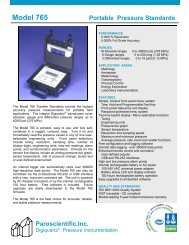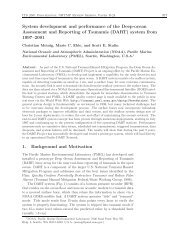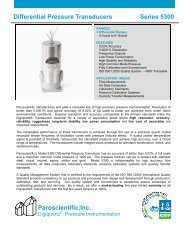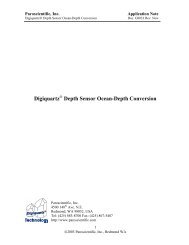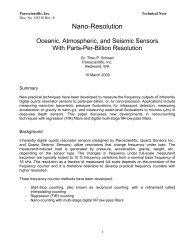FOR LOWïºFREQUENCY SEISMOMETRY - IRIS
FOR LOWïºFREQUENCY SEISMOMETRY - IRIS
FOR LOWïºFREQUENCY SEISMOMETRY - IRIS
- No tags were found...
You also want an ePaper? Increase the reach of your titles
YUMPU automatically turns print PDFs into web optimized ePapers that Google loves.
2.2.2. USArray & EarthScopeEarthScope is a set of integrated and distributed multi-purposegeophysical instrumentation that will provide the observationaldata needed to significantly advance knowledge andunderstanding of the structure and dynamics of the NorthAmerican continent. One element of EarthScope is USArray,a dense array of high-capability seismometers that willimprove greatly our resolution of the continental lithosphereand deeper mantle.USArray’s Backbone Network serves as a reference forthe continental-scale imaging being performed by USArray’stransportable components. As an integrated resource bothfor EarthScope science and seismic monitoring, the BackboneNetwork has been designed in close collaboration withthe USGS Advanced National Seismic System (ANSS) (seewww.ANSS.org). The proposed national broadband networkcomponent of the ANSS will consist of approximately 100stations, of which USArray will contribute 9 new GSN-qualitystations and 27 ANSS-quality stations.USArray has been unable to acquire STS-1 sensors andconsequently, the Backbone has been de-scoped and will useenhanced-performance STS-2 broadband sensors instead ofthe preferred STS-1 sensors.2.2.3. Other NetworksSeismic sensors find application in a number of other fields;however, the design requirements for these systems are lessdemanding than for low-frequency sensors, and the engineeringand production challenges tend to be driven by costminimization and environmental factors (size, ruggedness,reliability). Seismic networks to monitor nearby activity requiremoderate sensitivity, but only at higher frequencies, oforder 0.1 to 10.0 Hz. Engineering seismology applicationsfocus on higher signal levels (“strong motion”) and frequenciesup to 100 Hz. Sensors for the petroleum explorationindustry must cover the band from 4 to 500 Hz, be cheap,small, rugged, and easily deployed.2.3. Today’s SensorsHistorically, seismic sensors were separated into two generalclasses: those with long (15-30 sec) and short (1 sec) free periods.The former were used to measure long-period Earthmotion such as those characteristic of surface waves, whilethe latter sensors were used to measure high-frequency Earthmotions characteristic of body waves (seismic waves thattravel through Earth’s interior). The widespread applicationof force feedback has made this distinction less importantthan in the past. More recent designs favor broadband (fromnear zero frequency to around 50 Hz) feedback instrumentsfor most applications, but the mechanical sensor can stillhave either a short free period or a long free period. However,this approach is undergoing reappraisal.Although the mass-and-spring system is a useful mathematicalmodel for a seismometer, it is incomplete as a practicaldesign. The suspension must suppress five out of the sixdegrees of freedom of the seismic mass (three translationaland three rotational) but the mass must still move as freelyas possible in the remaining direction. Furthermore, it mustsuppress the disturbing influence caused by changes in gravity,magnetic, thermal, and barometric pressure. Carefulmanufacture is essential in order to reach the Brownian limitin the motion of the suspended mass.The dynamic range of the signals to be measured is large.Figure 1 showed that an acceleration-sensitive seismometerneeds a very large dynamic range in order to resolve with fullfidelity signals ranging from those barely above the noise tothose from earthquakes of magnitude 9.5.Excellent reviews of the history of seismometer design aregiven by Melton (1981a, 1981b), Farrell (1985), and Howell(1989). The design of the so-called very broadband seismometeris well described by Wielandt and Streckeisen (1982) andWielandt and Steim (1986).Seismic sensors can be characterized by their frequencyresponse, sensitivity, self-noise, and dynamic range.2.3.1. Frequency ResponseToday’s seismometers can be divided into three rough categories.Figure 3 shows the frequency response of a numberof seismic sensors.Short-period (SP) seismometers and geophones measuresignals from approximately 0.1 to 250 Hz, with lower cornerfrequencies between 1 and 10 Hz. Their response is usuallyflat with respect to ground velocity above this corner frequency.These units are technically simple and are readily available.High-quality units without significant parasitic resonance costaround $6,000; geophones cost a few hundred dollars.8



